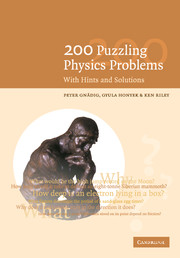Problems
Published online by Cambridge University Press: 05 October 2013
Summary
P1 Three small snails are each at a vertex of an equilateral triangle of side 60 cm. The first sets out towards the second, the second towards the third and the third towards the first, with a uniform speed of 5 cm min−1. During their motion each of them always heads towards its respective target snail. How much time has elapsed, and what distance do the snails cover, before they meet? What is the equation of their paths? If the snails are considered as point-masses, how many times does each circle their ultimate meeting point?
P2 A small object is at rest on the edge of a horizontal table. It is pushed in such a way that it falls off the other side of the table, which is 1 m wide, after 2 s. Does the object have wheels?
P3 A boat can travel at a speed of 3 m s−1 on still water. A boatman wants to cross a river whilst covering the shortest possible distance. In what direction should he row with respect to the bank if the speed of the water is (i) 2 m s−1, (ii) 4 m s−1? Assume that the speed of the water is the same everywhere.
P4 A long, thin, pliable carpet is laid on the floor. One end of the carpet is bent back and then pulled backwards with constant unit velocity, just above the part of the carpet which is still at rest on the floor.
- Type
- Chapter
- Information
- 200 Puzzling Physics ProblemsWith Hints and Solutions, pp. 1 - 49Publisher: Cambridge University PressPrint publication year: 2001
- 1
- Cited by

